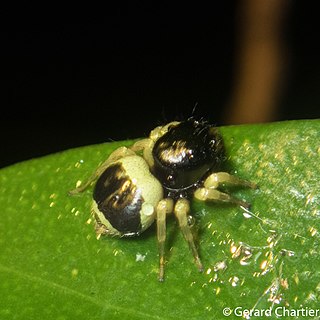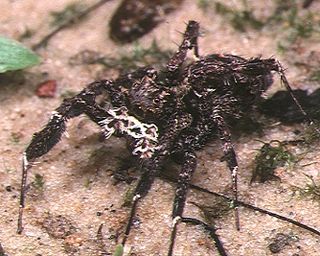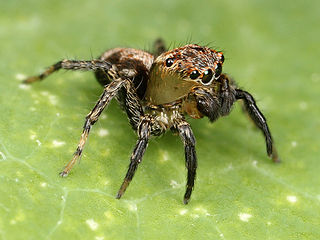Capeta is a genus of spiders in the family Salticidae.
Hyctiota is a genus of the jumping spiders found on the Moluccas in Indonesia. It is only described species is Hyctiota banda. Its taxonomic relationships within the family Salticidae are uncertain.

Pystira is a genus of spiders in the jumping spider family Salticidae.

The Spartaeinae are a subfamily of the spider family Salticidae. The subfamily was established by Fred R. Wanless in 1984 to include the groups Boetheae, Cocaleae, Lineae, Codeteae and Cyrbeae, which in turn were defined by Eugène Simon.
Vailimia masinei is a species of jumping spider in the family Salticidae. It is found in Borneo.

Salticinae is a subfamily of jumping spiders. It includes over 90% of the known species of jumping spiders. The subfamily is divided into two unranked clades: Amycoida and Salticoida.
Amatorculus stygius is a species of jumping spider in the family Salticidae. It is found in Brazil.

Lyssomaninae is a subfamily of jumping spiders. It includes four genera, three from the New World.
Ansienulina is a genus of spiders in the jumping spider family Salticidae. It was first described in 2015 by Wanda Wesołowska. This genus was named in honour of South African arachnologist Ansie Dippenaar-Schoeman. As of 2017, it contains only one species, Ansienulina mirabilis, found in Kenya, Angola, and Namibia.
Ragatinus is a genus of spiders in the family Salticidae. It was first described in 2016 by Angelika Dawidowicz and Wanda Wesołowska. As of 2017, it contains only one species, Ragatinus maddisoni.
Edwardsya is a genus of spiders in the family Salticidae. It was first described in 2016 by Ruiz & Bustamante. As of 2017, it contains 2 species, both from Brazil. The genus is placed in subtribe Freyina, part of the Salticoida clade in the subfamily Salticinae.

Orienticius is a genus of spiders in the family Salticidae. It was first described in 2016 by Prószyński. As of 2017, it contains 2 species.

Phintella lajuma is a species of jumping spider in the genus Phintella that lives in South Africa. It was first described in 2013 by Charles Haddad and Wanda Wesołowska, and given a name to reflect the fact that it was first found in the forests around Lajuma Mountain in Soutpansberg. Only the female has so far been described. The spider is medium-sized and lighter in colour than its relative Phintella lucida. It has a light brown carapace and yellow beige abdomen that has a pattern of linesand patches. The epigyne is distinctively large and has a plate at the rear.
Padillothorus is a genus of jumping spiders in the family Salticidae containing the single species, Padillothorus elegans. It was first described by Jerzy Prószyński in 2018, and has only been found in Indonesia.
Kakameganula is a monotypic genus of east African jumping spiders containing the single species, Kakameganula holmi. The genus was first described by Angelika Dawidowicz & Wanda Wesołowska in 2016 under the name Kakamega, and was placed in subtribe Thiratoscirtina within the tribe Aelurillini of the Salticoida clade of Salticinae.

The Sitticini are a tribe of spiders in the family Salticidae. The tribe has been divided into two subtribes, Aillutticina, with five Neotropical genera, and Sitticina, with five genera from Eurasia and the Americas. One genus is unplaced within the tribe. The taxonomy of the tribe has been subject to considerable uncertainty. It was clarified in 2020.
Eupoinae is a subfamily of jumping spiders. It was created in 2015 by Wayne Maddison. The subfamily has three genera.

Hisponinae is a subfamily of jumping spiders. The subfamily has six known extant genera and three extinct genera.
Manzuma is a genus of African jumping spiders erected by Galina Azarkina in 2020 as part of a study of genera placed in the subtribe Aelurillina. During the study, she found that several species formerly placed in Rafalus, Aelurillus and Langelurillus were similar and distinct enough from the type species of these genera. Accordingly, she erected a new genus, transferring four species in addition to describing three new ones.

Colonus hesperus is a species of jumping spider in the family Salticidae. It is found in the United States and Mexico.








